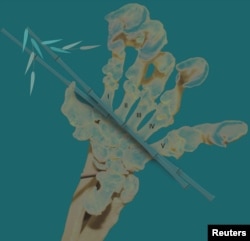Ancient bones unearthed in China are helping scientists better understand the development, or evolution, of modern pandas.
Pandas are a kind of animal called bears that live in forests in the mountains of Southwestern China. Pandas’ main food is a plant called bamboo. Currently, experts estimate the wild population of pandas is under 2,000.
Researchers recently reported that they discovered fossils, or mineralized bones, from an extinct panda called Ailurarctos. The fossils were found near the city of Zhaotong in the northern Yunnan Province in China. They are about 6 million years old and are from an ancestor to the modern panda.
The fossils helped scientists understand the evolution of a bone structure that helps pandas eat bamboo called a false thumb.
The false thumb found on Ailurarctos is similar to those found on modern pandas. But, it is longer and lacks a hook that living pandas use to eat bamboo.
The fossils are the oldest-known evidence of the false thumb, which is really an enlarged wrist bone called the radial sesamoid. The wrist is a joint of the body that permits the hand to move.
The false thumb is an adaptation that helps the existing five fingers, or digits, hold objects.
A bear’s hand lacks an opposable thumb, a true digit. Humans and other related animals, called primates, possess opposable thumbs. They permit primates to hold and handle objects using fingers. The false thumb operates in a similar way.
The researchers first found an Ailurarctos arm bone in 2010. They then discovered teeth and the false thumb in 2015, giving them a better understanding of the animal. Until now, the oldest-known evidence of this thumb-like structure was 102,000 to 49,000 years old. It came from the same kind of panda that is alive today.
The false thumb was not present in another closely related bear that lived about 9 million years ago, the researchers said.
Xiaoming Wang is the lead writer of the research published in the Scientific Reports. He studies fossils at the Natural History Museum of Los Angeles County.
Wang said: “It uses the false thumb as a very crude opposable thumb to grasp bamboo, sort of like our own thumbs except it is located at the wrist and is much shorter than human thumbs.”
The modern panda’s false thumb is more useful than the earlier version found in Ailurarctos.
Wang said the hooked false thumb offers a better grasp and it comes out less from the body. That makes it easier for the panda to walk. Wang said scientists think that is the reason the false thumb in modern pandas has become shorter, not longer.
The false thumb lets pandas hold bamboo to eat but not to turn the food as a thumb would permit.
Tao Deng of the Chinese Academy of Sciences in Beijing is a paleontologist and co-writer of the study. He said, “The panda’s false thumb is far less effective than the human thumb, but is enough to provide the giant panda with the grasping ability to eat bamboo.”
I’m Gregory Stachel.
Will Dunham reported this story for Reuters. Gregory Stachel adapted it for VOA Learning English.
________________________________________________________________________
Words in This Story
extinct – adj. no longer existing
hook – n. a curved or bent tool for catching, holding, or pulling something
adaptation – n. a change in a plant or animal that makes it better able to live in a particular place or situation
handle – v. to manage or control (something) with your hands
crude – adj. very simple and basic
grasp – v. to take and hold (something) with your fingers or hands
We want to hear from you. Write to us in the Comments section, and visit our Facebook page.










